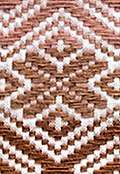Ikat
Ikat (literally means tie and in the malay language it means "to bind") is a dyeing technique used to pattern textiles that employs resist dyeing on the yarns prior to dyeing and weaving the fabric.
In ikat the resist is formed by binding individual yarns or bundles of yarns with a tight wrapping applied in the desired pattern. The yarns are then dyed. The bindings may then be altered to create a new pattern and the yarns dyed again with another colour. This process may be repeated multiple times to produce elaborate, multicolored patterns. When the dyeing is finished all the bindings are removed and the yarns are woven into cloth. In other resist-dyeing techniques such as tie-dye and batik the resist is applied to the woven cloth, whereas in ikat the resist is applied to the yarns before they are woven into cloth. Because the surface design is created in the yarns rather than on the finished cloth, in ikat both fabric faces are patterned.
A characteristic of ikat textiles is an apparent "blurriness" to the design. The blurriness is a result of the extreme difficulty the weaver has lining up the dyed yarns so that the pattern comes out perfectly in the finished cloth. The blurriness can be reduced by using finer yarns or by the skill of the craftsperson. Ikats with little blurriness, multiple colours and complicated patterns are more difficult to create and therefore often more expensive. However, the blurriness that is so characteristic of ikat is often prized by textile collectors.
Ikat is produced in many traditional textile centres around the world, from India to Central Asia, Southeast Asia, Japan (where it is called kasuri), Africa, and Latin America. Double ikats—in which both the warp and weft yarns are tied and dyed before being woven into a single textile—are relatively rare because of the intensive skilled labour required to produce them.
Types
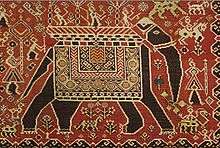
In warp ikat it is only the warp yarns that are dyed using the ikat technique. The weft yarns are dyed a solid colour. The ikat pattern is clearly visible in the warp yarns wound onto the loom even before the weft is woven in. Warp ikat is, amongst others, produced in Indonesia; more specifically in Kalimantan, Sulawesi, and Sumatra by respectively the Dayaks, Torajans and Bataks.[1]
In weft ikat it is the weaving of weft yarn that carries the dyed patterns. Therefore, the pattern only appears as the weaving proceeds. Weft ikats are much slower to weave than warp ikat because the weft yarns must be carefully adjusted after each passing of the shuttle to maintain the clarity of the design.
Double Ikat is a technique in which both warp and the weft are resist-dyed prior to weaving. Obviously it is the most difficult to make and the most expensive. Double ikat is only produced in three countries: India, Japan and Indonesia. The double ikat made in Patan, Gujarat in India is the most complicated. Called "patola," it is made using fine silk yarns and many colours. It may be patterned with a small motif that is repeated many times across the length of a six-meter sari. Sometimes the Patan double ikat is pictorial with no repeats across its length. That is, each small design element in each colour was individually tied in the warp and weft yarns. It's an extraordinary achievement in the textile arts. These much sought after textiles were traded by the Dutch East Indies company for exclusive spice trading rights with the sultanates of Indonesia. The double ikat woven in the small Bali Aga village, Tenganan in east Bali[2] in Indonesia reflects the influence of these prized textiles. Some of the Tenganan double ikat motifs are taken directly from the patola tradition. In India double ikat is also woven in Puttapaka, Nalgonda District and is called Puttapaka Saree.[3] In Japan, double ikat is woven in the Okinawa islands where it is called tate-yoko gasuri.[4]
Pasapalli Ikat is one of the Ikat saree and Pasapalli ikat saree made in Odisha. The word Pasapalli comes from 'Pasa' which means a board game with four clear parts (much like Ludo). Each pasapalli ikat saree or material - which is made with the same technique as the Sambalpuri Ikat - has some or the other form of this chequered design.[5]
Etymology
Ikat is an Indonesian language word, which depending on context, can be the nouns: cord, thread, knot and the finished ikat fabric as well as the verbs "to tie" or "to bind". It has a direct etymological relation to Javanese language of the same word. Thus, the name of the finished ikat woven fabric originates from the tali (threads, ropes) being ikat (tied, bound, knotted) before they are being put in celupan (dyed by way of dipping), then berjalin (woven, intertwined) resulting in a berjalin ikat- reduced to ikat.
The introduction of the term ikat into European language is attributed to Rouffaer.[6] Ikat is now a generic English loanword used to describe the process and the cloth itself regardless of where the fabric was produced or how it is patterned.
In Indonesian the plural of ikat remains ikat. However, in English a suffix plural 's' is commonly added, as in ikats. This is true in other some other languages. All are correct.
Distribution
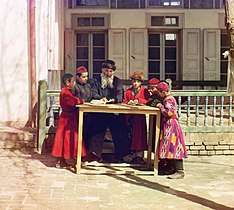
Ikat is a resist dyeing technique common to many world cultures. It is probably one of the oldest forms of textile decoration. However, it is most prevalent in Indonesia, India and Japan. In South America, Central and North America, ikat is still common in Argentina, Bolivia, Ecuador, Guatemala and Mexico, respectively.
In the 19th century, the Silk Road desert oases of Bukhara, Samarkand, Hotan and Kashgar (in what is now Uzbekistan and Xinjiang in Central Asia) were famous for their fine silk Uzbek/Uyghur ikat.
India, Japan, Indonesia and many other Southeast Asian nations including Cambodia, Myanmar, Philippines and Thailand have weaving cultures with long histories of ikat resist dyeing.
Double ikat textiles are still found in India, Japan and Indonesia. In Indonesia ikat textiles are produced throughout the islands from Sumarta in the west to Timor in the east and Kalimantan and Sulawesi in the north. Ikat is also found in Iran, where the Persian name is daraee. Daraee means wealth, and this fabric is often included in a bride's dowry during wedding ceremonies; and the people who buy these fabrics were rich.
History
As textiles do not last well through history, scholars have so far been unable to determine where the technique of ikat originated. Nevertheless, some parts of Asia demonstrate strong ikat traditions which suggest its possible origin; they are Maritime Southeast Asia, the Indian subcontinent and Central Asia.[8] However, it probably developed in several different locations independently.
The term "ikat" has Indonesian origin, and it was introduced into European textile vocabulary back in the early 20th century, when Dutch scholars begin to study the rich textile traditions of the East Indies archipelago (today Indonesia).[8]
Uyghurs call it atlas (IPA [ɛtlɛs]) and use it only for woman's clothing. The historical record indicates that there were 27 types of atlas during Qing Chinese occupation. Now there are only four types of Uyghur atlas remaining: qara-atlas, a black ikat used for older women's clothing; khoja'e-atlas, a yellow, blue, or purple ikat used for married women; qizil-atlas, a red ikat used for girls; and Yarkent-atlas, a khan or royal atlas.
Yarkent-atlas has more diverse styles; during the Yarkent Khanate (1514–1705), there were ten different styles of Yarkent-atlas.[9]
Production
Warp ikat
_TMnr_10014278.jpg)

Ikat created by dyeing the warps (warp ikat) is simpler to make than either weft ikat or double ikat. First the yarns--cotton, silk, wool or other fibres—are wound onto a tying frame. Then they are separated into bundles. As the binding process is very labor intensive an effort is made to reduce the work to a minimum by folding the thread bundles like in paper dolls and binding a basic ikat motif (BIM) that will be repeated like in paper dolls when the threads are unfolded for weaving after the dyeing is completed. The thread bundles may be folded around a vertical and/or horizontal axis. The bundles may be covered with wax, as in batik. (However, in making batik, the crafts person applies the resist to the finished cloth rather than to the yarns to be woven.) The warp yarns are then wrapped tightly with thread or some other dye-resistant material with the desired pattern so as to prevent unwanted dye penetration. The procedure is repeated, according to the number of colours required to complete the design. Multiple coloration is common, requiring multiple rounds of tying and dyeing. After the dyeing is finished the bindings are removed and the threads are wound onto the loom as the warp (longitudinal yarns). The threads are adjusted to precisely align the motifs and thin bamboo strips are lashed to the threads to prevent them from tangling or slipping out of alignment during weaving.
Some ikat traditions, such as Central Asia's, embrace a blurred aesthetic in the design. Other traditions favour a more precise and more difficult to achieve alignment of the ikat yarns. South American and Indonesian ikats are known for a high degree of warp alignment. Weavers carefully adjust the warp threads when they are placed on the loom so the patterns appear clearly. Thin strips of bamboo are then lashed to the warps to maintain the pattern alignment during weaving.
Patterns are visible in the warp threads even before the weft, a plain colored thread, is woven in. Some warp ikat traditions are designed with vertical-axis symmetry or have a "mirror-image" running along their long centre line. That is, whatever pattern or design is woven on the right is duplicated on the left in reverse order about a central warp thread group. Patterns can be created in the vertical, horizontal or diagonal.
Weft ikat
Weft ikat uses resist-dyeing for the weft yarns. The movement of the weft yarns in the weaving process means precisely delineated patterns are more difficult to achieve. The weft yarn must be adjusted after each passing of the shuttle to preserve the clarity of the patterns.
Nevertheless, highly skilled artisans can produce precise weft ikat. Japanese weavers produce very accurate indigo and white weft ikat with small scale motifs in cotton. Weavers in Odisha, India have replicated fine Urdu alphabet in weft ikat. In Thailand, weavers make silk sarongs depicting birds and complex geometrical designs in seven-colour weft ikat.
In some precise weft ikat traditions (Gujarat, India), two artisans weave the cloth: one passes the shuttle and the other adjusts the way the yarn lies in the shed.
As the weft is a continuous strand, aberrations or variations in the weaving tension are cumulative. Some weft ikat traditions incorporate this affect into their aesthetic. Patterns become transformed by the weaving process into irregular and erratic designs. Guatemalan ikat is well-noted for its beautiful "blurs."
Double ikat
Double ikat is created by resist-dyeing both the warp and weft prior to weaving.[10] Some sources use the term double ikat only when the warp and weft patterning overlap to form common, identical motifs. If they do not, the result is referred to as compound ikat.[11]
This form of weaving requires the most skill for precise patterns to be woven and is considered the premiere form of ikat. The amount of labour and skill required also make it the most expensive, and many poor quality cloths flood the tourist markets. Indian and Indonesian examples typify highly precise double ikat. Especially prized are the double ikats woven in silk known in India as patola (singular: patolu). These are from Khambat, Gujarat. During the colonial era, Dutch merchants used patola as prestigious trade cloths during the peak of the spice trade.[12]
In Indonesia double ikat is only woven in the Bali Aga village of Tenganan. These cloths have high spiritual significance. In Tenganan they are still worn for specific ceremonies. Outside Tenganan, geringsing are treasured as they are purported to have magical powers.[2]
The double ikat of Japan is woven in the Okinawa islands and is called tate-yoko gasuri.[4]
_from_Odisha.jpg)

Pochampally Saree, a variety from a small village in Nalgonda district, Andhra Pradesh, India is known for silk saris woven in the double Ikat.
The Puttapaka Saree[13] is made in Puttapaka village, Samsthan Narayanpuram mandal in Nalgonda district, India. It is known for its unique style of silk saris. The symmetric design is over 200 years old. The Ikat is warp-based. The Puttapaka Saree is a double ikat.
Before the weaving is done, a manual winding of yarn, called Asu, needs to be performed. This process takes up to five hours per sari and is usually done by the womenfolk, who suffer physical strain through constantly moving their hands back and forth over 9000 times for each sari. In 1999, a young weaver C Mallesham developed a machine which automated Asu, thus developing a technological solution for a decades-old unsolved problem.[14]
Ōshima
Ōshima ikat is a uniquely Japanese ikat. In Amami Ōshima, the warp and weft threads are both used as warp to weave stiff fabric, upon which the thread for the ikat weaving is spot-dyed. Then the mats are unravelled and the dyed thread is woven into Ōshima cloth.
The Ōshima process is duplicated in Java and Bali, and is reserved for ruling royalty, notably Klungkung and Ubud: most especially the dodot cloth semi-cummerbund of Javanese court attire.
Other countries
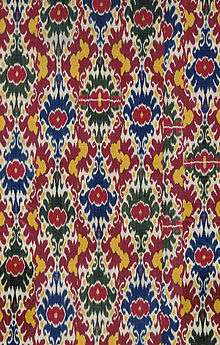
Cambodia
The Cambodian ikat is a weft ikat woven of silk on a multi-shaft loom with an uneven twill weave, which results in the weft threads showing more prominently on the front of the fabric than the back.[15][16]
By the 19th century, Cambodian ikat was considered among the finest textiles of the world. When the King of Thailand came to the US in 1856, he brought as a gift for President Franklin Pierce fine Cambodian ikat cloth.[17] The most intricately patterned of the Cambodian fabrics are the sampot hol—skirts worn by the women—and the pidans—wall hangings used to decorate the pagoda or the home for special ceremonies.
Unfortunately, Cambodian culture suffered massive disruption and destruction during the mid-20th century Indochina wars but most especially during the Khmer Rouge regime. Most weavers were killed and the whole art of Cambodian ikat was in danger of disappearing.
Kikuo Morimoto is a prominent pioneer in re-introducing ikat to Cambodia. In 1995, he moved from Japan and located one or two elderly weavers and Khmer Rouge survivors who knew the art and have taught it to a new generation.
Thailand
In Thailand, the local weft ikat type of woven cloth is known as Matmi (also spelled 'Mudmee' or 'Mudmi').[18] Traditional Mudmi cloth was woven for daily use among the nobility. Other uses included ceremonial costumes. Warp ikat in cotton is also produced by the Karen and Lawa tribal peoples in northern Thailand.
This type of cloth is the favourite silk item woven by Khmer people living in southern Isan, mainly in Surin, Sisaket and Buriram provinces.[19]
Iran
In Iran, ikat, known by the name darayee, has been woven in different areas. In Yazd, there are some workshops that produce it. It is said that this kind of cloth historically used to be included in a bride's dowry. In popular culture, there is a quote that states that people who bought this type of cloth were wealthy.[20]
Latin America
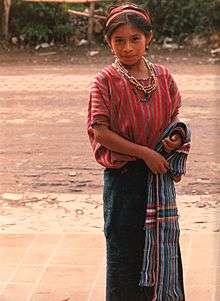
Ikat patterns are common among the Andes peoples, and native people of Argentina, Bolivia, Brazil, Chile, Colombia, Ecuador, Guatemala, Mexico, Peru, and Venezuela. The Mapuche shawl or poncho of the Huaso cowboys of Chile is perhaps the item best known in the West. Wool and cabuya fibre are the most commonly used. India: In india Ikat art is present since thousands of years . Now also some parts of India this Ikat processed cloth like saree and kurtis are much popular . bedsheet, door screen, towels are also much preferred one.
The Mexican rebozos can be made from silk, wool or cotton and are frequently ikat dyed. These shawls are seen as a part of the Mexican national identity and most women own at least one.
Latin American ikat (Jaspe, as it is known to Maya weavers) textiles are commonly woven on a back-strap loom. Pre-dyed warp threads are a common item in traditional markets- saving the weaver much mess, expense, time and labour.[21][22] A Latin American innovation which may also be employed elsewhere is to employ a round stick around which warp threads are wrapped in groups, thus allowing more precise control of the desired design.[21] The "corte" is the typical wrap-skirt used worn by Guatemalan women.
Accreditation
As of 2010, the government of the Republic of Indonesia announced it would pursue UNESCO Intangible Cultural Heritage accreditation for its ikat weaving, along with songket, and gamelan having successfully attained this UNESCO recognition for its wayang, batik and the kris.[23]
See also
References
- Bali by Michael Möbius, Annette Ster
- Balinese Textiles; Brigitta Hauser-Schaublin, Marie-Louise Nabhollz-kartaschoff, Urs Ramseyer. British Museum Press. ISBN 0-7141-2505-9 p.117
- "APonline - History and Culture-Arts and Crafts - Ikat". aponline.gov.in. Archived from the original on 19 January 2014. Retrieved 30 August 2014.
- Tomito J & N. Kasuri. Japanese Ikat Weaving, The Techniques of Kasuri, . Routledge & Kegan Paul. ISBN 0-7100-9043-9, 1982 p.7
- "About Pasapalli Ikat".
- Umesh Charan Patnaik, Aswini Kumar Mishra, 1997. Handloom industry in action. 1997. pp38. G. K. Ghosh, Shukla Ghosh, 2000. Ikat textiles of India. 2000
- "Dress Codes: Revealing the Jewish Wardrobe" Archived 3 July 2014 at the Wayback Machine
- Ruth Barnes. "Ikat". Love to Know. Archived from the original on 14 November 2016.
- Abdukerim Raxman, Reweydulla Hemdulla, Sherip Xushtar, Uyghur Örp-Adetliri, Urumqi, 1996
- Guy, John. Indian Textiles in the East. London, Thames & Hudson, 2009, pp. 10, 24.
- Larsen, Jack Lenor (1976). The Dyer's Art ikat, batik, plangi. New York: Van Nostrand Reinhold. p. 129. ISBN 0442246854.
- Balinese Textiles; Brigitta Hauser-Schaublin, Marie-Louise Nabhollz-kartaschoff, Urs Ramseyer. British Museum Press. ISBN 0-7141-2505-9
- "Textiles". indiaheritage.org. Archived from the original on 4 July 2013. Retrieved 30 August 2014.
- Asu machine to aid weavers of tie and dye sarees Archived 11 October 2012 at the Wayback Machine
- [Mattiebelle Gittinger and H. Leedom Lefforts,Textiles and the Thai Experience in South-East Asia, Washington, DC 1992, PP38–39]
- Gill Green,"The Cambodia Weaving Tradition: Little Known Weaving and Loom Artifacts,"Arts of Asia, vold.27, no. 5, Hong Kong, 199, pp. 86–87
- Gettinger, op.cit., pp 149. 167
- Silk at Ban Sawai Archived 19 July 2011 at the Wayback Machine
- Chusak Sukaranandana - Woven cloth, an exquisite handicraft of Thai-Lao-Khmer ethnic groups in Thailand Archived 18 August 2011 at the Wayback Machine
- http://donya-e-eqtesad.com/بخش-بیشتر-26/472405-دارایی-بافته-ای-از-ابریشم-رنگ Archived 8 February 2018 at the Wayback Machine
- Waddington, Laverne (3 May 2010). "Backstrap weaving-cross knit looping tutorial and ikat". Backstrap Weaving. Retrieved 3 May 2010.
- "Central Asian Ikats from the Rau Collection". Victoria and Albert Museum. Archived from the original on 14 November 2007. Retrieved 13 November 2007.
- "Batik, Wayang, Keris: Jadi Warisan Budaya Dunia". Indonesian. Antara News Indonesia. Archived from the original on 23 May 2010. Retrieved 3 May 2010.
Further reading
- Gillow, John; Dawson, Barry. (1995) Traditional Indonesian Textiles. Thames and Hudson. ISBN 0-500-27820-2
- Ghosh, G. K.; Ghosh, Shukla (2000). Ikat Textiles of India. APH Publishing. ISBN 9788176481670.
- Gibbon, Kate Fitz; Hale, Andrew (1997). Ikat: Silks of Central Asia : the Guido Goldman Collection. Laurence King. ISBN 9781856691017.
External links
| Wikimedia Commons has media related to Ikat. |
- Ikat from the University of Washington Burke Museum of Natural History and Culture
- Art of Ikat at Europeana. Retrieved February 2012
- a weaving site that teaches you about ikat
- "Making ikat cloth". Victoria and Albert Museum. Retrieved 13 November 2007.
- "The Extraordinary Ikat" - The newsletter of ArtXchange (Summer/Autumn 2003) from Internet Archive
- "South American Ikat". South America. Waddington. Retrieved 3 May 2010.
- National Museum of Australia: Ikat techniques adapted for surfwear
- What is ikat? Transnational Ikat: An Asian Textile on the Move. Holy Cross Website. Retrieved 19 March 2017.
%2C_Central_Sulawesi_(Celebes)%2C_Rongkong%2C_Toraja%2C_cotton_with_ikat_paterns.jpg)
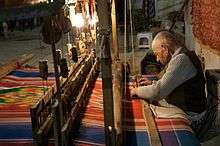


.jpeg)
